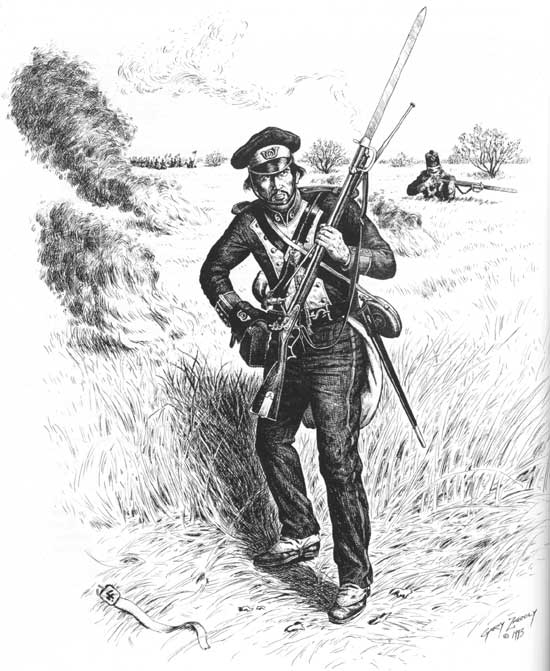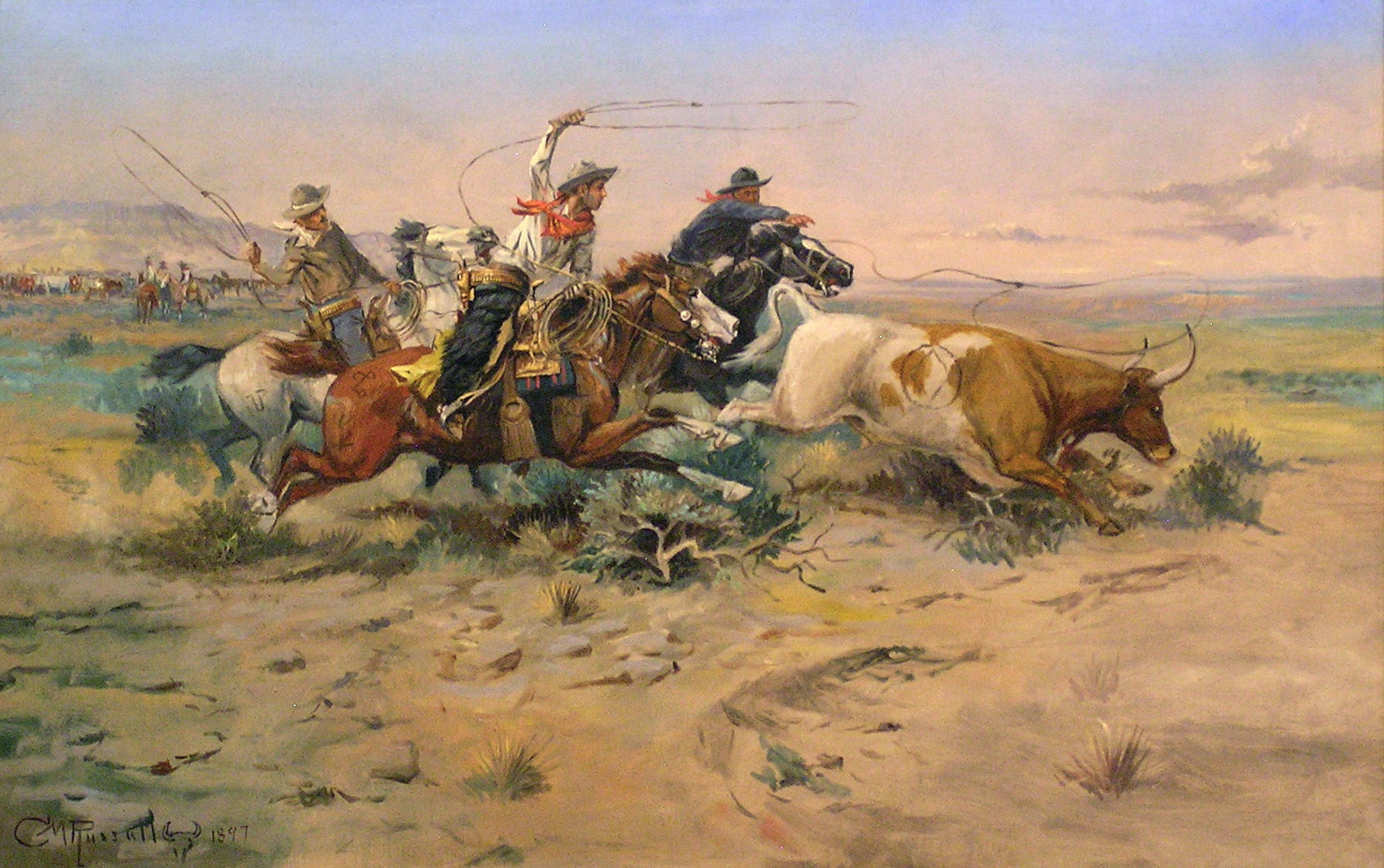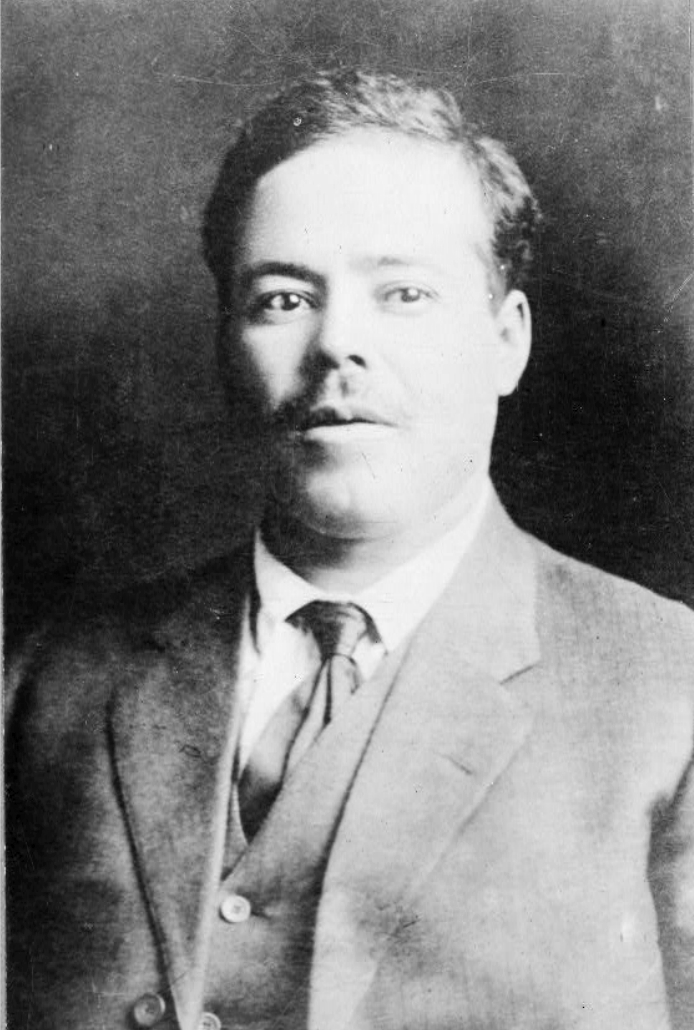|
Juan Cortina
Juan Nepomuceno Cortina Goseacochea (May 16, 1824 – October 30, 1894), also known by his nicknames Cheno Cortina, the Red Robber of the Rio Grande and the Rio Grande Robin Hood, was a Mexican rancher, politician, military leader, outlaw and folk hero. He was an important caudillo, military general and regional leader, who effectively controlled the Mexican state of Tamaulipas as governor. In borderlands history he is known for leading a paramilitary mounted Mexican Militia in the failed Cortina Wars. The "Wars" were raids targeting Anglo-American civilians whose settlement Cortina opposed near the several leagues of land granted to his wealthy family on both sides of the Rio Grande. Anglo families began immigrating to the Lower Rio Grande Valley after the Mexican Army was defeated by the Anglo-Mexican rebels of the Mexican State of Tejas, in the Texas Revolution. From 1836 to 1848 when Cortina was 12–24 years old, parts of the Cortina Grant North of the Rio Grande ... [...More Info...] [...Related Items...] OR: [Wikipedia] [Google] [Baidu] |
Camargo, Tamaulipas
Camargo is a Municipalities of Tamaulipas, municipality in the Mexico, Mexican Mexican state, state of Tamaulipas. It is located on the US-Mexico border, US border, across from Rio Grande City, Texas. It has an official population of 14,933 inhabitants (2010 census). The municipal seat is Ciudad Camargo, with a population of 7,984. The municipality is connected to Rio Grande City, Texas, via the Rio Grande City-Camargo International Bridge. History The first settlement to be founded on the Lower Río Grande was that of Nuestra Señora de Santa Ana de Camargo. It was founded on March 5, 1749, with the dedication to Señora Santa Ana by captain Don Blas María de la Garza Falcón at the eastern edge of the San Juan River (Tamaulipas), San Juan River near its confluence with the Río Grande. The foundation had 85 families – a total of 531 persons. Most of the settlers for this township came from Cerralvo Municipality, Cerralvo, Cadereyta Jiménez massacre, Cadereyta, Monterrey and ... [...More Info...] [...Related Items...] OR: [Wikipedia] [Google] [Baidu] |
Brownsville, Texas
Brownsville ( ) is a city in the U.S. state of Texas and the county seat of Cameron County, Texas, Cameron County, located on the western Gulf Coast in South Texas, adjacent to the Mexico–United States border, border with Matamoros, Tamaulipas, Mexico. The city covers , and had a population of 186,738 at the 2020 United States Census, 2020 census. As of the 2020 U.S. Census, it is the List of United States cities by population, 136th-most populous city in the United States and List of cities in Texas by population, 18th-most populous in Texas. It is part of the Matamoros–Brownsville metropolitan area. The city is known for its year-round subtropical climate, deep-water seaport, and Hispanic culture. The city was founded in 1848 by American entrepreneur Charles Stillman after he developed a successful river-boat company nearby. It was named for Fort Brown, itself named after Major Jacob Brown (Texas soldier), Jacob Brown, who fought and died while serving as a United States Ar ... [...More Info...] [...Related Items...] OR: [Wikipedia] [Google] [Baidu] |
Treaty Of Guadalupe Hidalgo
The Treaty of Guadalupe Hidalgo officially ended the Mexican–American War (1846–1848). It was signed on 2 February 1848 in the town of Villa de Guadalupe, Mexico City, Guadalupe Hidalgo. After the defeat of its army and the fall of the capital in September 1847, Mexico entered into peace negotiations with the U.S. envoy, Nicholas Trist. The resulting treaty required Mexico to cede 55 percent of its territory including the present-day states of California, Nevada, Utah, most of Colorado, New Mexico and Arizona, and a small portion of Wyoming. Mexico also relinquished all claims for Texas and recognized the Rio Grande as the southern boundary of Texas. In turn, the U.S. government paid Mexico $15 million "in consideration of the extension acquired by the boundaries of the United States" and agreed to pay debts owed to American citizens by the Mexico, Mexican government. Mexico, Mexicans in areas annexed by the U.S. could relocate within Mexico's new boundaries or receive Amer ... [...More Info...] [...Related Items...] OR: [Wikipedia] [Google] [Baidu] |
Battle Of Resaca De La Palma
The Battle of Resaca de la Palma was one of the early engagements of the Mexican–American War, where the United States Army under General Zachary Taylor engaged the retreating forces of the Mexican ''Ejército del Norte'' ("Army of the North") under General Mariano Arista on May 9, 1846. The United States emerged victorious and forced the Mexicans out of Texas. Background Following the Mexican defeat at the Battle of Palo Alto the previous day, Arista on the morning of May 9 moved his forces to a more defensible position along a resaca, known as Resaca de Guerrero to the Mexicans but as Resaca de la Palma to the Americans. Recalling his experiences at the Siege of Fort Texas, he positioned his forces along the twelve foot deep and two hundred foot wide resaca, three miles from the Rio Grande, by 10 a.m. Arista placed most of his infantry in the ravine, thickly forested on either side, to negate the effectiveness of Taylor's artillery, with the 6th and 10th Infantry, Sa ... [...More Info...] [...Related Items...] OR: [Wikipedia] [Google] [Baidu] |
Battle Of Palo Alto
The Battle of Palo Alto () was the first major battle of the Mexican–American War and was fought on May 8, 1846, on disputed ground five miles (8 km) from the modern-day city of Brownsville, Texas. A force of some 3,700 Mexico, Mexican troops – most of the ''Army of The North'' – led by General Mariano Arista engaged a force of approximately 2,300 United States troops – the Army of Occupation (Mexico), Army of Occupation led by General Zachary Taylor. On April 30, following the Thornton Affair, Mexican General Mariano Arista's troops began to cross the Rio Grande. On May 3, the troops began to Siege of Fort Texas, besiege the American outpost at Fort Brown, Fort Texas. Taylor marched his Army of Occupation south to relieve the siege. Arista, upon learning of his approach, diverted many of his units away from the siege to meet Taylor's force. The battle took place on May 8, three days before the formal declaration of war on Mexico by the United States. Arista ordered ... [...More Info...] [...Related Items...] OR: [Wikipedia] [Google] [Baidu] |
Cavalry
Historically, cavalry (from the French word ''cavalerie'', itself derived from ''cheval'' meaning "horse") are groups of soldiers or warriors who Horses in warfare, fight mounted on horseback. Until the 20th century, cavalry were the most mobile of the combat arms, operating as light cavalry in the roles of reconnaissance, Screening (tactical), screening, and skirmisher, skirmishing, or as heavy cavalry for decisive economy of force and shock attacks. An individual soldier in the cavalry is known by a number of designations depending on era and tactics, such as a cavalryman, Equestrianism, horseman, trooper (rank), trooper, cataphract, knight, Drabant Corps of Charles XII, drabant, hussar, uhlan, mamluk, cuirassier, lancer, dragoon, samurai or horse archer. The designation of ''cavalry'' was not usually given to any Military animal, military forces that used other animals or platforms for mounts, such as chariots, Camel cavalry, camels or War elephant, elephants. Infantry who m ... [...More Info...] [...Related Items...] OR: [Wikipedia] [Google] [Baidu] |
Cowboy
A cowboy is an animal herder who tends cattle on ranches in North America, traditionally on horseback, and often performs a multitude of other ranch-related tasks. The historic American cowboy of the late 19th century arose from the ''vaquero'' traditions of northern Mexico and became a figure of special significance and legend.Malone, J., p. 1. A subtype, called a Wrangler (profession), wrangler, specifically tends the horses used to work cattle. In addition to ranch work, some cowboys work for or participate in rodeos. Cowgirls, first defined as such in the late 19th century, had a less-well documented historical role, but in the modern world work at identical tasks and have obtained considerable respect for their achievements. Cattle handlers in many other parts of the world, particularly South America and Australia, perform work similar to the cowboy. The cowboy has deep historic roots tracing back to Spain and the earliest European Settlement of the Americas, settlers of th ... [...More Info...] [...Related Items...] OR: [Wikipedia] [Google] [Baidu] |
Zachary Taylor
Zachary Taylor (November 24, 1784 – July 9, 1850) was an American military officer and politician who was the 12th president of the United States, serving from 1849 until his death in 1850. Taylor was a career officer in the United States Army, rising to the rank of major general and becoming a national hero for his victories in the Mexican–American War. As a result, he won election to the White House despite his vague political beliefs. His top priority as president was to preserve the Union. He died 16 months into his term from a stomach disease. Taylor had the third-shortest presidential term in U.S. history and was the third president whose death has been traced to poor sanitation in Washington DC. Taylor was born into a prominent family of plantation owners who moved westward from Virginia to Louisville, Kentucky, in his youth. He was the last president born before the adoption of the Constitution. He was commissioned as an officer in the U.S. Army in 1808 and made ... [...More Info...] [...Related Items...] OR: [Wikipedia] [Google] [Baidu] |
Mariano Arista
José Mariano Martín Buenaventura Ignacio Nepomuceno García de Arista Nuez (26 July 1802 – 7 August 1855) was a Mexican soldier and politician who also became president of Mexico. He was in command of the Mexican forces at the opening battles of the Mexican American War: the Battle of Palo Alto and the Battle of Resaca de la Palma, which were disastrous losses for Mexico and resulted in Arista being court martialled though eventually acquitted. He continued to play a notable role in government and was Minister of War under President Jose Joaquin Herrera. Arista himself would succeed Herrera as president and his inauguration would mark the first peaceful transfer of power in Mexico since 1824. The Herrera and Arista administrations occurring immediately after the end of the Mexican American War were eras of stability, moderate rule, and economic growth. Writing in 1920, Mexican historian Francisco Bulnes rated Arista as the greatest of Mexico's presidents. Arista, however ... [...More Info...] [...Related Items...] OR: [Wikipedia] [Google] [Baidu] |
Pancho Villa
Francisco "Pancho" Villa ( , , ; born José Doroteo Arango Arámbula; 5 June 1878 – 20 July 1923) was a Mexican revolutionary and prominent figure in the Mexican Revolution. He was a key figure in the revolutionary movement that forced out President and dictator Porfirio Díaz and brought Francisco I. Madero to power in 1911. When Madero was ousted by a coup led by General Victoriano Huerta in February 1913, Villa joined the anti-Huerta forces in the Constitutionalist Army led by Venustiano Carranza. After the defeat and exile of Huerta in July 1914, Villa broke with Carranza. Villa dominated the Convention of Aguascalientes, meeting of revolutionary generals that excluded Carranza and helped create a coalition government. Emiliano Zapata and Villa became formal allies in this period. Like Zapata, Villa was strongly in favor of land reform, but did not implement it when he had power. At the height of his power and popularity in late 1914 and early 1915, the U.S. conside ... [...More Info...] [...Related Items...] OR: [Wikipedia] [Google] [Baidu] |
Garza Revolution
The Garza Revolution, or the Garza War, was an armed conflict fought in the Mexican state of Coahuila and the American state of Texas between 1891 and 1893. It began when the revolutionary Catarino Garza launched a campaign into Mexico from Texas to start an uprising against the dictator Porfirio Diaz. Because of this violation of neutrality, the United States Army became involved and assisted the Mexican Army in tracking down Garza's followers. The war was relatively minor compared to other similar conflicts in Mexican history though it has been seen as a precursor to the major Mexican Revolution from 1910 to 1920. War 1891 The Garza Revolution was one of many outbreaks of rebellion during the four decades of Porfirio Diaz' regime. In September, Garza issued a statement, declaring that the citizens of Mexico were "''treated like despicable slaves, that the Mexican government was plagued by frightful corruption, that freedom of the press had been squashed, and that the Consti ... [...More Info...] [...Related Items...] OR: [Wikipedia] [Google] [Baidu] |






